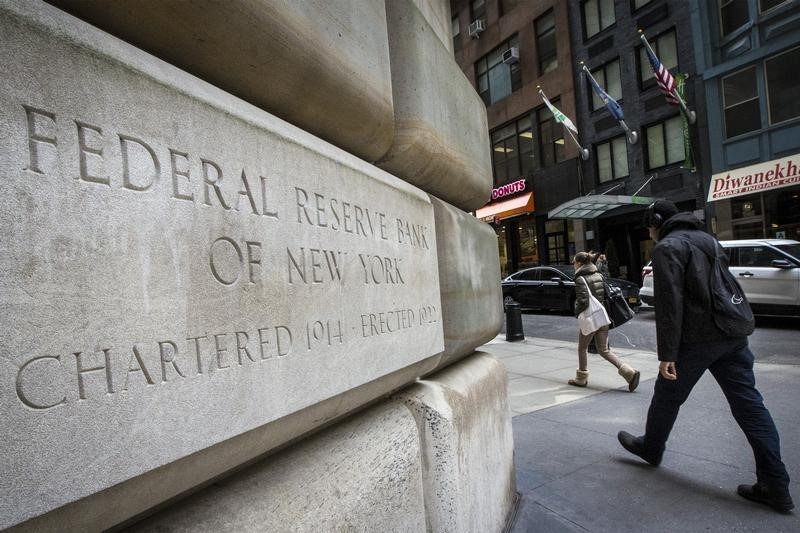(Bloomberg) -- Jerome Powell and his Federal Reserve colleagues are staring down the possibility of mass bankruptcies and long-lasting unemployment unless there’s a more concerted government effort to shield the U.S. economy from the impact of the coronavirus pandemic.
That’s the context in which the Fed chair will speak Wednesday at 9 a.m. during a virtual event with the Peterson Institute for International Economics in Washington, though he may be loath to give clear hints on future monetary policy, with the central bank’s next rate decision still a month out.
“Powell is likely to push back on adopting negative rates, reinforce his willingness to continue using balance sheet tools, and lean on fiscal policy makers to do more,” said Neil Dutta, head of economics at Renaissance Macro Research in New York.
Powell and his colleagues on the central bank’s Federal Open Market Committee have already cut their benchmark interest rate to nearly zero, engaged in open-ended bond buying and begun rolling out emergency lending programs as U.S. unemployment has soared to levels not seen since the 1930s Great Depression.
But they’ve also insisted more can and probably will need to be done, both by the central bank and by lawmakers who have already backed $2 trillion in virus relief. Democrats on Tuesday proposed a further $3 trillion in aid, though the plan has little chance of quickly gaining traction with President Donald Trump or Senate Republicans.
That still leaves a question about what future fiscal measures might look like, and whether anything more will be on tap for the FOMC’s next scheduled meeting on June 9-10.
Negative Rates
Investors have begun to speculate that the Fed may opt to take its benchmark overnight rate into negative territory, following in the footsteps of central banks in Europe and Japan. Implied yields on futures contracts linked to the federal funds rate have gone below zero in recent days.
Fed officials have long maintained that they are not keen on imitating their Japanese and European counterparts, however, and continue to argue against adopting negative rates in the U.S.
“My colleagues on the Federal Open Market Committee have been pretty unanimous in saying we don’t think that’s likely,” Minneapolis Fed President Neel Kashkari said Tuesday during a virtual event streamed on YouTube. “There are other tools we would go to first.”
Yield Curve Control
More likely would be a move toward a so-called yield-curve control policy. That would entail the central bank setting a target for yields on longer-term Treasury securities in addition to its overnight benchmark, and buying or selling Treasuries as needed to hit the target.
It’s something the Bank of Japan has implemented successfully in recent years, and something that Fed officials had been discussing as a possible crisis measure to consider down the road, before the coronavirus outbreak began.
The Fed is already buying lots of Treasuries. Since mid-March, it’s added about $1.5 trillion of them to its balance sheet. Initially, the stated rationale was to restore liquidity in financial markets after investor panic seized them up. Now, as market function improves, the Fed will probably continue buying, but with the aim of keeping long-term yields low -- harking back to the so-called quantitative easing programs it relied on last time its benchmark rate was at the zero bound.
Forward Guidance
An eventual shift toward yield-curve control or a more structured approach to bond buying could ultimately also be accompanied by clearer guidance on what would drive the Fed’s decision-making. The central bank’s current guidance is that its benchmark rate will remain pinned near zero “until it is confident that the economy has weathered recent events and is on track to achieve its maximum employment and price stability goals.”
Some, like former New York Fed officials Krishna Guha and Simon Potter, are calling for the FOMC to be more specific. They advocate a pledge to keep rates at zero at least until the unemployment rate has fallen back down to 4%.
“We would like to see a very strong lean in to enhanced forward guidance and regular open-ended QE,” Guha, now vice chairman of Evercore ISI in Washington, wrote Tuesday in a note to clients.
“Our baseline expectation is a more moderate lean that does not rule out negative rates in all states of the world and stops short of embracing our own aggressive forward guidance proposals or a specific June timeline for delivering new policy settings.”
©2020 Bloomberg L.P.
